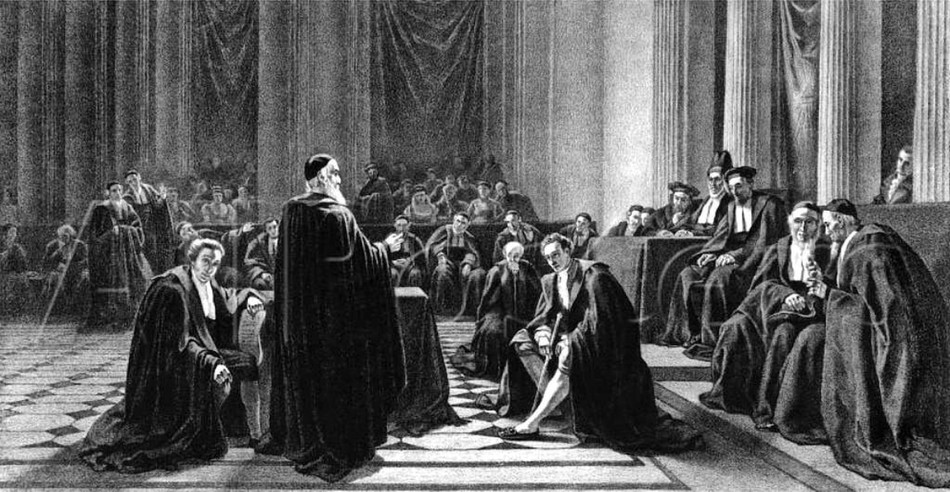The Sanhedrin was a Jewish judicial and religious council during the time of Jesus and in the early years of the Christian movement. The term "Sanhedrin" is derived from the Greek word "synedrion," meaning assembly or council. The Sanhedrin played a significant role in the governance and religious affairs of the Jewish people in the first century.
The Sanhedrin in the Bible
In the Bible, particularly in the New Testament, the Sanhedrin is mentioned in connection with the trial of Jesus and the persecution of early Christian leaders. Read the biblical account of Jesus' trial before the Sanhedrin in Matthew 26:57-67:
Jesus Before the Sanhedrin
57 Those who had arrested Jesus took him to Caiaphas the high priest, where the teachers of the law and the elders had assembled. 58 But Peter followed him at a distance, right up to the courtyard of the high priest. He entered and sat down with the guards to see the outcome.
59 The chief priests and the whole Sanhedrin were looking for false evidence against Jesus so that they could put him to death. 60 But they did not find any, though many false witnesses came forward.
Finally two came forward 61 and declared, “This fellow said, ‘I am able to destroy the temple of God and rebuild it in three days.’”
62 Then the high priest stood up and said to Jesus, “Are you not going to answer? What is this testimony that these men are bringing against you?” 63 But Jesus remained silent.
The high priest said to him, “I charge you under oath by the living God: Tell us if you are the Messiah, the Son of God.”
64 “You have said so,” Jesus replied. “But I say to all of you: From now on you will see the Son of Man sitting at the right hand of the Mighty One and coming on the clouds of heaven.”
65 Then the high priest tore his clothes and said, “He has spoken blasphemy! Why do we need any more witnesses? Look, now you have heard the blasphemy. 66 What do you think?”
“He is worthy of death,” they answered.
67 Then they spit in his face and struck him with their fists. Others slapped him 68 and said, “Prophesy to us, Messiah. Who hit you?”
In the book of Acts, Peter and John performed a miraculous healing of a man who had been lame from birth. This miracle took place at the Beautiful Gate of the temple in Jerusalem. Following the healing, Peter and John were arrested by the temple authorities, as the religious leaders were disturbed by the apostles' teaching about Jesus and the resurrection. The arrest led to their appearance before the Sanhedrin in Acts 4:1-22:
Peter and John Before the Sanhedrin
The priests and the captain of the temple guard and the Sadducees came up to Peter and John while they were speaking to the people. 2 They were greatly disturbed because the apostles were teaching the people, proclaiming in Jesus the resurrection of the dead. 3 They seized Peter and John and, because it was evening, they put them in jail until the next day. 4 But many who heard the message believed; so the number of men who believed grew to about five thousand.
5 The next day the rulers, the elders and the teachers of the law met in Jerusalem. 6 Annas the high priest was there, and so were Caiaphas, John, Alexander and others of the high priest’s family. 7 They had Peter and John brought before them and began to question them: “By what power or what name did you do this?”
8 Then Peter, filled with the Holy Spirit, said to them: “Rulers and elders of the people! 9 If we are being called to account today for an act of kindness shown to a man who was lame and are being asked how he was healed, 10 then know this, you and all the people of Israel: It is by the name of Jesus Christ of Nazareth, whom you crucified but whom God raised from the dead, that this man stands before you healed. 11 Jesus is
“‘the stone you builders rejected, which has become the cornerstone.'
12 Salvation is found in no one else, for there is no other name under heaven given to mankind by which we must be saved.”
13 When they saw the courage of Peter and John and realized that they were unschooled, ordinary men, they were astonished and they took note that these men had been with Jesus. 14 But since they could see the man who had been healed standing there with them, there was nothing they could say. 15 So they ordered them to withdraw from the Sanhedrin and then conferred together. 16 “What are we going to do with these men?” they asked. “Everyone living in Jerusalem knows they have performed a notable sign, and we cannot deny it. 17 But to stop this thing from spreading any further among the people, we must warn them to speak no longer to anyone in this name.”
Sanhedrin Definition
The Greek term for “Sanhedrin” appears 12 times in the four gospels and 14 times in the Book of Acts. Many newer English Bible translations sometimes or always use the term “court” or “council.”
In Matthew 10:17 and Mark 13:9, the word “Sanhedrins” refers to the ruling councils in every city with a sizable Jewish population.
Otherwise, with the possible exception of Matthew 5:22, the word “Sanhedrin” refers to the highest ruling body in Jerusalem. That is, until the Roman Empire’s destruction of Jerusalem and the Second Temple in AD 70.
Later, the Sanhedrin moved back to Jerusalem and was active for several centuries. It was disbanded in AD 358 and permanently disbanded in AD 425. There have been half a dozen orthodox Judaism attempts to restore the Sanhedrin. Those attempts took place in 1538, 1830, 1901, 1940, 1949, and 2004. We very well may see it successfully restored in the coming years.
Why is the Sanhedrin so important? It was the supreme legal, legislative, and judicial body for Jews living everywhere. Beginning in 191 BC, the Sanhedrin was led by a president or prince (Nasi) and a vice president, dean, or chancellor (Av beis din).
That said, at times, the Sanhedrin was still influenced or greatly influenced by the high priest and his closest male relatives.
According to Sanhedrin.org, “The Sanhedrin became the battleground between the Pharisees and the Sadducees for the control of the leadership of the Jewish people.” In the end, the Sadducees won control, but the Pharisees won people’s hearts.
Who Were the Sadducees?
At the time of Jesus Christ, the high priest and his fellow Sadducees acted like Jewish aristocrats. Talk about a bunch of rich fools. They ruled the Temple and ran the Lord right out the door.
They denied some of the most basic teachings of Scripture — life after death, heaven, hell, angels, demons, miracles (Acts 23:8) — to the point of casting doubt on God Himself.
That’s probably why we have no record of even one Sadducee obeying the Greatest Commandment, let alone becoming a Christian.
No wonder Jesus harshly rebuked them and said, “Your problem is that you don’t know the Scriptures, and you don’t know the power of God” (Matthew 22:29, NLT).
After Pentecost, the Sadducees “were very disturbed that Peter and John were teaching the people that through Jesus there is a resurrection of the dead” (Acts 4:2, NLT). They arrested the two leading apostles (Acts 4:3) and later threw the whole lot into jail (Acts 5:17-18).
What irony that God sent an angel to perform a spectacular miracle that freed the apostles and threw the Sadducees into a fit.
Like the Sadducees, you and I can be tempted to doubt certain supernatural details of God’s Word. Yet if God is God, nothing is impossible!
Unlike the Sadducees, let’s stand in awe of the Lord God, gladly acknowledge His mighty power, and heed His every word.
To discover more about what Jesus thought of the Sadducees, see Matthew 22:23-33, Mark 12:18-27, and Luke 20:27-40.
Also, see Acts 23:6-8, which shows the huge differences (within the Sanhedrin) between the Sadducees and Pharisees.
Unlike the Pharisees, the Sadducees quickly vanished after AD 70.
Who Were the Pharisees?
Unlike the Sadducees, the Pharisees were “believers.” They believed in God, angels, miracles, the Ten Commandments, and the prophecies of old.
Down through the centuries, however, some Pharisees went so far as to reinterpret the scriptures and follow strict rules governing all manner of external behavior. They did all this in order to look ultra-righteous.
Yet Jesus warned, “Unless your righteousness is better than the righteousness of the teachers of religious law and the Pharisees, you will never enter the Kingdom of Heaven!” (Matthew 5:20, NLT).
Why such a harsh rebuke? It turns out some of the Pharisees in Jesus’ day had placed their own rules above God’s Word and looked down on everyone else.
They were far more interested in their own power and prestige than in God’s glory and honor. Talk about a bunch of legalists.
When Jesus started going out of His way to break the minute “laws” invented and revered by these legalists, they saw red. They couldn’t stand it when He emphasized obeying the spirit of Scripture from the heart.
Why, here was a commoner, they thought, asserting His authority over their hallowed man-made traditions!
The more convincingly Jesus demonstrated His deity as God the Father’s Son, the more bloodthirsty some of the Pharisees became.
Finally, they decided to work out a plan to assassinate this subversive folk hero from Galilee, so much for heeding God’s Word and His promised Messiah.
Sadly, many religious legalists seek to wield power in our own day. If we’re not careful, you and I also can end up focusing on the external aspects of Christianity instead of on an ongoing, daily, heartfelt relationship with the Lord Himself.
Unlike the legalistic Pharisees, let’s take God at His Word and daily choose to love Him with all our heart, soul, strength, and mind (Matthew 22:34-40; Mark 12:30-31).
To discover more about what Jesus thought of the Pharisees, see Matthew 12:1-45, 15:1-20, 16:5-12, 21:33-22:22, and 23:1-36 or the many passages in Mark, Luke, or John.
Unlike the Sadducees, the traditions of the Pharisees continued as Rabbinic Judaism and, as such, survived to this day.
Just remember: Jesus didn’t see all Pharisees as enemies of the gospel.
Never forget that Nicodemus (John 3:1), Joseph of Arimathea (Mark 15:43), and other sincere Pharisees placed their belief, faith, and trust in Jesus Christ, God’s Son, and our Lord and Savior.
This includes Saul, later known as Paul, who in Philippians 3:5-6 admits he had been the ultimate Pharisaical legalist, to the point of harshly persecuting Christians and having many imprisoned and put to death (Acts 9:1-31).
For further reading:
How Was it the Right Time for Jesus’ Life on Earth?
What Are the Basics of Jesus’ Teaching?
Who Were the Pharisees in the Bible?
What Is Legalism? Definition and Examples
How Do We Love the Lord with All Our Hearts, Souls, and Minds?
Why Is Jesus’ Divinity Important?
Did Paul Know That His Letters Would be Scripture?
Photo Credit: Painting by Edward Moyse, 1868




.jpg)
